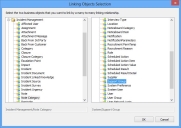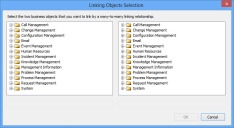Linking unlinked business objects
Sometimes you will want to link objects together that are not currently linked together. For example, you could link the incident note category object with the support group object to associate specific support groups with specific incident note categories. This would then enable you to create a filter that displays only those categories on an incident note that are associated with the specific support group.
For more information about creating object filters, see Data filtering.
The first step is to link the business objects together, then you can link the specific items together.
To create the linking object:
- Start the Object Designer component.
- On the Business Objects tree, select the module folder in which you want to create the linking object.
For example, Incident Management.
The objects you can link do not depend on the module you select: the module you select only sets the module in which the linking object will be created. However, we recommend that you select a module that contain one of the objects you are linking.
- On the Actions list, click New Linking Business Object.
The Linking Objects Selection dialog appears.
- In the tree on the left of the dialog, expand the relevant module folder.
For example, Incident Management. - Select the required business object.
For example Note Category. - In the tree on the right-hand side of the dialog, select the module and business object with which you want to link the Note Category.
For example, System, then Support Group.
- Click OK.
A new business object is created, and two attributes are automatically added. Notice that the icon for the new object is .
. - Type a Title for the business object, for example NoteGroupLink.
- You do not need to specify any additional attributes, so click
 .
.
You will see a new collection on each of the selected business objects. In this example, the new collection will appear on both the Note Category business object and the Support Group business object.
Now that you have linked the objects together, you can link the individual records together. If one of the objects that you have linked is under the User Management tree, a new folder appears under each linked record for that object, which you can drag items onto from another instance of the Administration component. The recommended method for linking the records together, however, is to add a multi-select list box to the window for one or both of the objects that you have linked.
For information about adding multi-select list boxes to a window, see Adding multi-select list boxes to a window.
When you have linked two objects together, you can add Create and Delete actions for the linking object from the process object using the Manage Business Object Actions action.
